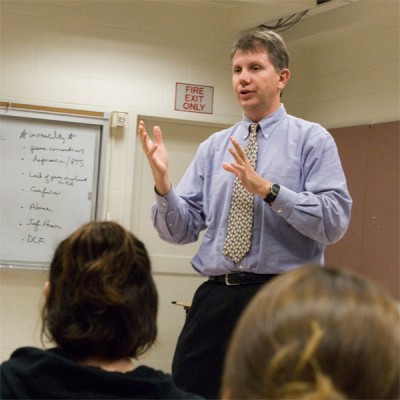
It will come as no surprise to any college student (or parent of one) that achieving success in higher education starts with the right preparation during the K-12 years. But for students with disabilities, postsecondary education presents an additional set of challenges, though they too can be met with the right strategies in place.
In their new book, Preparing Students with Disabilities for College Success, Neag Associate Professor Joseph Madaus, Professor Emeritus Stan Shaw, and University of South Florida Associate Professor and UConn graduate Lyman Dukes III have put together what they describe as a guide to transition planning. The book is aimed at both educators and parents of students who have a range of learning disabilities, autism, ADHD and emotional disturbances, with the goal of, as the title says, college success. But it is also aimed at changing the debate.
For too long, in Shaw’s view, transition planning for high school students with disabilities has focused on transition to employment, with postsecondary education virtually ignored. That, Shaw says, is a mistake. “For students with these mild-to-moderate disabilities, the data shows that if they can do well in college, it’s the one intervention that levels the playing field throughout their employment careers.”
He adds that the Neag School leads the nation in fostering access to college for students with disabilities, through its Center on Postsecondary Education and Disability (CPED), which was created in 1984. Shaw is its former director, Madaus its current one.
While their book covers a broad spectrum of topics with research articles from a variety of experts, it also highlights the need for early planning, starting in the elementary grades and continuing into high school, to better prepare students with disabilities for the college experience. “That includes proper course work,” Madaus says, “but also preparation for the SAT and other tests. It can also mean being prepared to take college courses, with good note-taking skill and time management. These are the same issues other students face. They become more challenging for the student with disabilities.”
Equally essential, the authors say, is helping the student become a better “self-advocate” for his or her particular needs. “Part of that,” Madaus says, “involves students learning how to talk to adults about their disability. But the adults also need to listen, and make the student a participant in the process of his or her own education.”
For Shaw and Madaus, the heart of the book and of their work on behalf of students with disabilities, is fair and equal access for all, a goal they’ve approached on different paths. For Shaw, it was a natural progression from his work as a civil rights activist in the 1960s. For Madaus, it began with a summer job at a camp for children with disabilities. For both, it’s a new front in a long battle to help students with disabilities move more easily into postsecondary education. As Madaus puts it, “It is all about giving them an opportunity to succeed.”
 Facebook
Facebook
 Twitter
Twitter
 LinkedIn
LinkedIn
